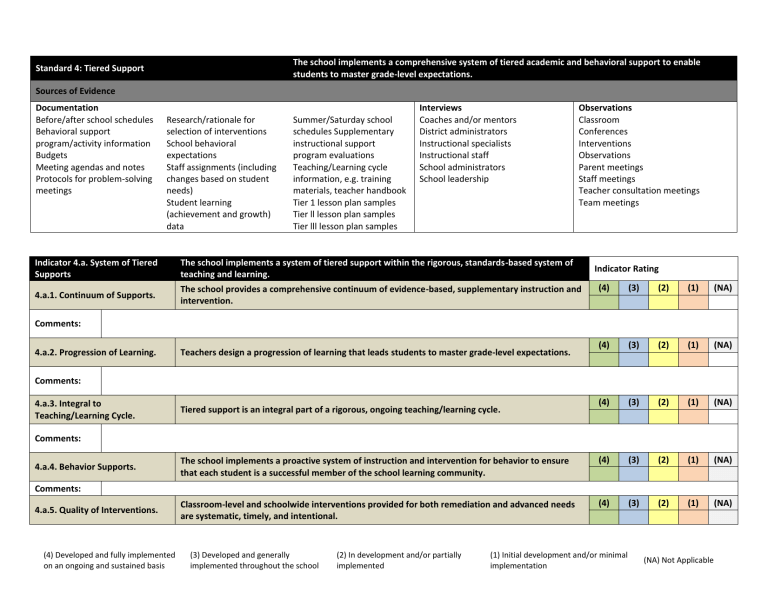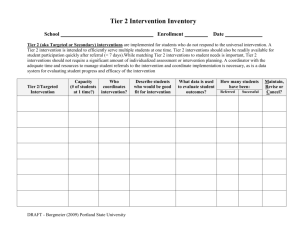Standard 4: Tiered Support The school implements a

Standard 4: Tiered Support
Sources of Evidence
Documentation
Before/after school schedules
Behavioral support program/activity information
Budgets
Meeting agendas and notes
Protocols for problem-solving meetings
Indicator 4.a. System of Tiered
Supports
4.a.1. Continuum of Supports.
Research/rationale for selection of interventions
School behavioral expectations
Staff assignments (including changes based on student needs)
Student learning
(achievement and growth) data
The school implements a system of tiered support within the rigorous, standards-based system of teaching and learning.
The school implements a comprehensive system of tiered academic and behavioral support to enable students to master grade-level expectations.
Summer/Saturday school schedules Supplementary instructional support program evaluations
Teaching/Learning cycle information, e.g. training materials, teacher handbook
Tier 1 lesson plan samples
Tier ll lesson plan samples
Tier lll lesson plan samples
Interviews
Coaches and/or mentors
District administrators
Instructional specialists
Instructional staff
School administrators
School leadership
The school provides a comprehensive continuum of evidence-based, supplementary instruction and intervention.
Observations
Classroom
Conferences
Interventions
Observations
Parent meetings
Staff meetings
Teacher consultation meetings
Team meetings
Indicator Rating
(4) (3) (2) (1) (NA)
Comments:
4.a.2. Progression of Learning. Teachers design a progression of learning that leads students to master grade-level expectations.
(4) (3) (2) (1) (NA)
Comments:
4.a.3. Integral to
Teaching/Learning Cycle.
Tiered support is an integral part of a rigorous, ongoing teaching/learning cycle.
(4) (3) (2) (1) (NA)
Comments:
4.a.4. Behavior Supports.
Comments:
4.a.5. Quality of Interventions.
The school implements a proactive system of instruction and intervention for behavior to ensure that each student is a successful member of the school learning community.
Classroom-level and schoolwide interventions provided for both remediation and advanced needs are systematic, timely, and intentional.
(4) (3) (2) (1) (NA)
(4) (3) (2) (1) (NA)
(4) Developed and fully implemented on an ongoing and sustained basis
(3) Developed and generally implemented throughout the school
(2) In development and/or partially implemented
(1) Initial development and/or minimal implementation
(NA) Not Applicable
Comments:
4.a.6. Research/Needs Based.
Comments:
4.a.7. Flexible Resource
Allocation.
Comments:
4.a.8. Ongoing Monitoring.
All intervention models, programs, or strategies are research based and delivered to meet the individual learning needs of students.
The school allocates time, materials, and personnel to respond to student learning concerns based on need.
(4) (3) (2) (1) (NA)
(4) (3) (2) (1) (NA)
Comments:
4.a.9. Student Participation
Criteria.
Comments:
4.a.10. Job-Embedded
Professional Learning.
Comments:
Indicator 4.b. Multiple Learning
Opportunities
The school uses clear criteria and processes for making decisions regarding level and length of student participation in tiered supports.
The school staff engages in ongoing, job-embedded professional learning (including coaching) to help improve implementation of tiered academic and behavioral supports.
4.b.1. Tiered Supports.
Comments:
4.b.2. Best First Instruction.
(4) (3) (2) (1) (NA)
(4) (3) (2) (1) (NA)
Students who do not learn effectively through best first instruction are provided multiple opportunities to learn, first within their classroom, grade-level team, and/or department, and then beyond the classroom.
The school provides multiple opportunities and interventions for students in need using a system that includes at least three tiers including best first instruction, Tier II (targeted/supplemental), and
Tier III (intensive).
Indicator Rating
(4) (3) (2) (1) (NA)
Instructional staff places a primary focus on the best first instruction of all students.
(4) (3) (2) (1) (NA)
The school ensures ongoing, frequent use of data to monitor that learning is accelerated or enriched as intended.
(4) (3) (2) (1) (NA)
4.b.3. Tier II Interventions.
Comments:
4.b.4. Tier II Extended
Tier II grade level or content instructional interventions are provided for students performing below mastery to supplement their classroom instruction.
(4) (3) (2) (1) (NA)
Tier II extended enrichment opportunities are available for students performing above mastery to (4) (3) (2) (1) (NA)
(4) Developed and fully implemented on an ongoing and sustained basis
(3) Developed and generally implemented throughout the school
(2) In development and/or partially implemented
(1) Initial development and/or minimal implementation
(NA) Not Applicable
Enrichment. supplement their classroom instruction.
Comments:
4.b.5. Tier III Remedial
Intervention.
4.b.6. Tier III Advanced
Intervention.
Comments:
Tier III interventions are provided with sufficient time, intensity, and frequency to meet individual remedial needs of students at the highest risk of failure or dropping out of school.
Tier III interventions are provided with sufficient time, intensity, and frequency to specifically meet individual student advanced needs.
4.b.7. Integrated Support.
Comments:
Support structures and programs (e.g., Title I, ESL, Special Education) are integrated into the school’s tiered intervention process to provide collaborative support for student learning.
4.b.8. Extended Learning
Opportunities.
Comments:
4.b.9. Accountability.
Comments:
Indicator 4.c. Family and
Community Partnerships
4.c.1. Partnerships for Student
Success.
Comments:
The school offers a range of extended learning opportunities within and beyond the school day and the school year.
School leadership routinely monitors tiered supports and interventions to ensure they are delivered with fidelity and provide feedback regarding effective implementation.
The school develops and sustains family and community partnerships to share responsibility for student success.
Collaborative partnerships with families and the community are cultivated and emphasize shared responsibility for the success of students.
4.c.2. Active Family Participation.
Families are active participants in the problem-solving model to identify concerns, determine strategies, and implement actions to support positive student outcomes.
Comments: ,,
4.c.3. Supported Family
Partnerships.
Comments:
The school ensures families are provided opportunities to be partners in supporting student learning (e.g., math nights, parenting classes).
(4) (3) (2) (1) (NA)
(4) (3) (2) (1) (NA)
(4) (3) (2) (1) (NA)
(4) (3) (2) (1) (NA)
(4) (3) (2) (1) (NA)
Indicator Rating
(4) (3) (2) (1) (NA)
(4) (3) (2) (1) (NA)
(4) (3) (2) (1) (NA)
(4) Developed and fully implemented on an ongoing and sustained basis
(3) Developed and generally implemented throughout the school
(2) In development and/or partially implemented
(1) Initial development and/or minimal implementation
(NA) Not Applicable
4.c.4. External Support.
Comments:
The school communicates timely information to students and families regarding available external support services such as health and social services.
(4) (3) (2) (1) (NA)
(4) Developed and fully implemented on an ongoing and sustained basis
(3) Developed and generally implemented throughout the school
(2) In development and/or partially implemented
(1) Initial development and/or minimal implementation
(NA) Not Applicable





